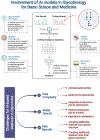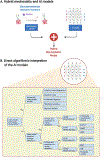Artificial intelligence in the analysis of glycosylation data
- PMID: 35738510
- PMCID: PMC11157671
- DOI: 10.1016/j.biotechadv.2022.108008
Artificial intelligence in the analysis of glycosylation data
Abstract
Glycans are complex, yet ubiquitous across biological systems. They are involved in diverse essential organismal functions. Aberrant glycosylation may lead to disease development, such as cancer, autoimmune diseases, and inflammatory diseases. Glycans, both normal and aberrant, are synthesized using extensive glycosylation machinery, and understanding this machinery can provide invaluable insights for diagnosis, prognosis, and treatment of various diseases. Increasing amounts of glycomics data are being generated thanks to advances in glycoanalytics technologies, but to maximize the value of such data, innovations are needed for analyzing and interpreting large-scale glycomics data. Artificial intelligence (AI) provides a powerful analysis toolbox in many scientific fields, and here we review state-of-the-art AI approaches on glycosylation analysis. We further discuss how models can be analyzed to gain mechanistic insights into glycosylation machinery and how the machinery shapes glycans under different scenarios. Finally, we propose how to leverage the gained knowledge for developing predictive AI-based models of glycosylation. Thus, guiding future research of AI-based glycosylation model development will provide valuable insights into glycosylation and glycan machinery.
Keywords: Artificial intelligence; Glycosylation machinery; Interpretable models; Multi-omics integration.
Copyright © 2022. Published by Elsevier Inc.
Conflict of interest statement
Declaration of Competing Interest The authors declare no conflict of interest.
Figures



Similar articles
-
Systems Glycobiology: Integrating Glycogenomics, Glycoproteomics, Glycomics, and Other 'Omics Data Sets to Characterize Cellular Glycosylation Processes.J Mol Biol. 2016 Aug 14;428(16):3337-3352. doi: 10.1016/j.jmb.2016.07.005. Epub 2016 Jul 15. J Mol Biol. 2016. PMID: 27423401 Review.
-
Immunoglobulin G N-glycan Biomarkers for Autoimmune Diseases: Current State and a Glycoinformatics Perspective.Int J Mol Sci. 2022 May 6;23(9):5180. doi: 10.3390/ijms23095180. Int J Mol Sci. 2022. PMID: 35563570 Free PMC article. Review.
-
Sweet systems: technologies for glycomic analysis and their integration into systems biology.Crit Rev Biochem Mol Biol. 2021 Jun;56(3):301-320. doi: 10.1080/10409238.2021.1908953. Epub 2021 Apr 5. Crit Rev Biochem Mol Biol. 2021. PMID: 33820453 Review.
-
Correcting for sparsity and interdependence in glycomics by accounting for glycan biosynthesis.Nat Commun. 2021 Aug 17;12(1):4988. doi: 10.1038/s41467-021-25183-5. Nat Commun. 2021. PMID: 34404781 Free PMC article.
-
Big-Data Glycomics: Tools to Connect Glycan Biosynthesis to Extracellular Communication.Trends Biochem Sci. 2021 Apr;46(4):284-300. doi: 10.1016/j.tibs.2020.10.004. Epub 2020 Dec 18. Trends Biochem Sci. 2021. PMID: 33349503 Free PMC article. Review.
Cited by
-
Advancement in Clinical Glycomics and Glycoproteomics for Congenital Disorders of Glycosylation: Progress and Challenges Ahead.Biomedicines. 2025 Aug 13;13(8):1964. doi: 10.3390/biomedicines13081964. Biomedicines. 2025. PMID: 40868218 Free PMC article. Review.
-
De Novo Glycan Annotation of Mass Spectrometry Data.J Am Soc Mass Spectrom. 2025 Aug 6;36(8):1686-1695. doi: 10.1021/jasms.5c00093. Epub 2025 Jul 2. J Am Soc Mass Spectrom. 2025. PMID: 40605194 Free PMC article.
-
Simple and practical sialoglycan encoding system reveals vast diversity in nature and identifies a universal sialoglycan-recognizing probe derived from AB5 toxin B subunits.Glycobiology. 2022 Nov 22;32(12):1101-1115. doi: 10.1093/glycob/cwac057. Glycobiology. 2022. PMID: 36048714 Free PMC article.
-
Glycosylation in autoimmune diseases: A bibliometric and visualization study.Heliyon. 2024 Apr 23;10(9):e30026. doi: 10.1016/j.heliyon.2024.e30026. eCollection 2024 May 15. Heliyon. 2024. PMID: 38707406 Free PMC article.
-
Analysis of carbohydrates and glycoconjugates by matrix-assisted laser desorption/ionization mass spectrometry: An update for 2021-2022.Mass Spectrom Rev. 2025 May-Jun;44(3):213-453. doi: 10.1002/mas.21873. Epub 2024 Jun 24. Mass Spectrom Rev. 2025. PMID: 38925550 Free PMC article. Review.
References
-
- Aizpurua-Olaizola O, Sastre Toraño J, Falcon-Perez JM, Williams C, Reichardt N, & Boons G-J, 2018. Mass spectrometry for glycan biomarker discovery. Trends Analyt. Chem. 100, 7–14. 10.1016/j.trac.2017.12.015. - DOI
-
- Antonakoudis A, Strain B, Barbosa R, Jimenez del Val I, & Kontoravdi C, 2021. Synergising stoichiometric modelling with artificial neural networks to predict antibody glycosylation patterns in Chinese hamster ovary cells. Comput. Chem. Eng. 154, 107471. 10.1016/j.compchemeng.2021.107471. - DOI
Publication types
MeSH terms
Substances
Grants and funding
LinkOut - more resources
Full Text Sources
Medical

